
German submarine U-552 was a Type VIIC U-boat built for Nazi Germany's Kriegsmarine for service during World War II. She was laid down on 1 December 1939 at Blohm & Voss in Hamburg as yard number 528, launched on 14 September 1940, and went into service on 4 December 1940. U-552 was nicknamed the Roter Teufel after her mascot of a grinning devil, which was painted on the conning tower. She was one of the more successful of her class, operating for over three years of continual service and sinking or damaging 35 Allied ships with 164,276 GRT and 1,190 tons sunk and 26,910 GRT damaged. She was a member of 21 wolf packs.
German submarine U-571 was a Type VIIC U-boat built for the Kriegsmarine of Nazi Germany for service during World War II. U-571 conducted eleven war patrols, sinking five ships totalling 33,511 gross register tons (GRT), and damaging one other for 11,394 GRT. On 28 January 1944 she was attacked by an Australian-crewed Sunderland aircraft from No. 461 Squadron RAAF west of Ireland and was destroyed by depth charges. All hands were lost.
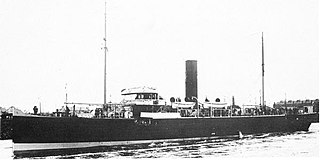
Q-ships, also known as Q-boats, decoy vessels, special service ships, or mystery ships, were heavily armed merchant ships with concealed weaponry, designed to lure submarines into making surface attacks. This gave Q-ships the chance to open fire and sink them. The use of Q-ships contributed to the abandonment of cruiser rules restricting attacks on unarmed merchant ships and to the shift to unrestricted submarine warfare in the 20th century.
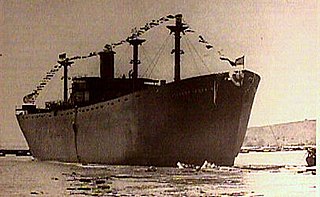
SS Stephen Hopkins was a United States Merchant Marine Liberty ship that served in World War II. She was the only US merchant vessel to sink a German surface combatant during the war.
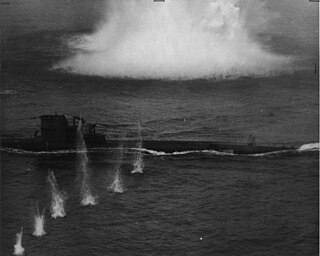
German submarine U-134 was a Type VIIC U-boat of Nazi Germany's Kriegsmarine during World War II. She was laid down on 6 September 1940 by Bremer Vulkan in Bremen-Vegesack as yard number 13 and commissioned on 26 July 1941. In seven patrols, U-134 sank three ships for a total of 12,147 gross register tons (GRT).

German submarine U-255 was a Type VIIC U-boat that served in Nazi Germany's Kriegsmarine during World War II. The submarine was laid down on 21 December 1940 at the Bremer Vulkan yard at Bremen-Vegesack, launched on 8 October 1941 and commissioned on 29 November 1941 under the command of Kapitänleutnant Reinhart Reche.

The Battle of the Caribbean refers to a naval campaign waged during World War II that was part of the Battle of the Atlantic, from 1941 to 1945. German U-boats and Italian submarines attempted to disrupt the Allied supply of oil and other material. They sank shipping in the Caribbean Sea and the Gulf of Mexico and attacked coastal targets in the Antilles. Improved Allied anti-submarine warfare eventually drove the Axis submarines out of the Caribbean region.

SS Fort Lee was a T2 tanker built for the United States Maritime Commission during World War II. The ship was assigned by the War Shipping Administration for operation by the Bernuth Lembcke Co. and operated in the Atlantic and Mediterranean early in its career.

USCGC Seneca, or before 1915 USRC Seneca, was a United States Coast Guard cutter built and commissioned as a "derelict destroyer" with the specific mission of locating and then destroying abandoned shipwrecks that were still afloat and were a menace to navigation. She was designed with excellent sea-keeping qualities, a long cruising range, good towing capabilities, and by necessity the capacity to store a large amount of munitions. She was one of five Coast Guard cutters serving with the U.S. Navy in European waters during World War I.
German submarine U-177 was a Type IXD2 U-boat of Nazi Germany's Kriegsmarine during World War II. The submarine was laid down on 25 November 1940, at the DeSchiMAG AG Weser yard in Bremen, as yard number 1017. She was launched on 1 October 1941, and commissioned on 14 March 1942, under the command of Kapitänleutnant Wilhelm Schulze. After a period of training with the 4th U-boat Flotilla at Stettin, the boat was transferred to the 10th flotilla on 1 October 1942, and based at Lorient, for front-line service, she was then reassigned to the 12th flotilla at Bordeaux on 1 December.
SS Santa Rita was a refrigerated cargo ship built for the United States Maritime Commission by Federal Shipbuilding of Kearny, New Jersey in 1941. Operated by the Grace Line, Santa Rita en route from Cape Town to Charleston, South Carolina, when she was attacked by German submarine U-172 on 9 July 1942. Steaming on a non-evasive course at 16 knots (30 km/h) 700 nautical miles (1,300 km) northeast of Puerto Rico, a single torpedo from U-172 hit the ship in the near the engine room. The explosion destroyed the engines; opened a 30-foot (9.1 m) hole in the hull of the ship, which immediately flooded the No. 3 cargo hold; and killed one officer and two men. After ten minutes, the ship's master, Henry Stephenson, ordered the ship abandoned; most of the surviving officers and crew and the ship's two passengers had already boarded the Nos. 3 and 4 lifeboats.
USS YP-389 was a United States Navy yard patrol (YP) boat that served in World War II. The ship was built in 1941 as the fishing trawler Cohasset at the Fore River Shipyard in Quincy, Massachusetts, for R. O'Brien and Company.

SS West Humhaw was a steel–hulled cargo ship built in 1918 as part of the United States Shipping Board's emergency World War I shipbuilding program.
The Torpedo Alley, or Torpedo Junction, off North Carolina, is one of the graveyards of the Atlantic Ocean, named for the high number of attacks on Allied shipping by German U-boats in World War II. Almost 400 ships were sunk, mostly during the Second Happy Time in 1942, and over 5,000 people were killed, many of whom were civilians and merchant marines. Torpedo Alley encompassed the area surrounding the Outer Banks, including Cape Lookout and Cape Hatteras.

United States Navy operations during World War I began on April 6, 1917, after the formal declaration of war on the German Empire. The American navy focused on countering enemy U-boats in the Atlantic Ocean and the Mediterranean Sea, while convoying men and supplies to France and Italy. Because of United States' late entry into the war, her capital ships never engaged the German fleet, and few decisive submarine actions occurred.

German submarine U-161 was a Type IXC U-boat of Nazi Germany's Kriegsmarine built for service during World War II. The keel for this boat was laid down on 23 March 1940 at the Deutsche Schiff und maschinenbau AG, Bremen yard as yard number 700. She was launched on 1 March 1941 and commissioned on 8 July under the command of Kapitänleutnant Hans-Ludwig Witt.
German submarine U-576 was a Type VIIC U-boat of Nazi Germany's Kriegsmarine during World War II. She carried out five patrols, sinking four ships of 15,450 gross register tons (GRT) and damaging two more of 19,457 GRT. She was sunk on 15 July 1942 by depth charges from two US aircraft and gunfire from a merchant ship, near the East Coast of the United States. The wreck was discovered in August 2014.
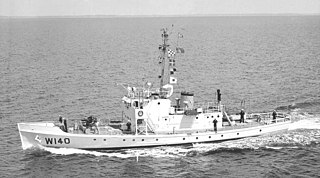
USCGC Legare (WSC-144) was a United States Coast Guard cutter that served in the Coast Guard for almost forty-one years.

SS Cynthia Olson was a cargo ship originally built in Wisconsin in 1918 as the SS Coquina. Renamed in 1940, in August 1941 she was chartered by the US Army to transport supplies to Hawaii. While in passage between Tacoma, Washington and Honolulu on December 7, she was intercepted by the Japanese submarine I-26, which sank her with gunfire. Although the commander of the submarine ensured that all of the crew had escaped into boats, none of them was ever found. Cynthia Olson was the first United States Merchant Marine vessel to be sunk after the entry of the United States into World War II.
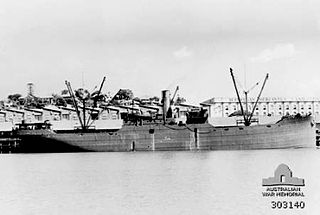
SS Coast Trader was built as the cargo ship SS Holyoke Bridge in 1920 by the Submarine Boat Company in Newark, New Jersey. The Coast Trader was torpedoed and sank 35 miles (56 km) south west of Cape Flattery, off the Strait of Juan de Fuca in U.S. state of Washington by the Japanese submarine I-26. Survivors were rescued by schooner Virginia I and HMCS Edmundston. She rests on the ocean floor at.













